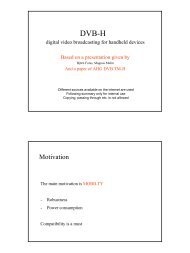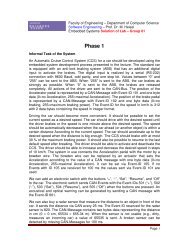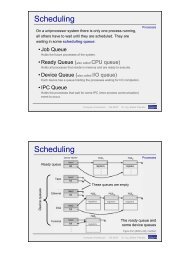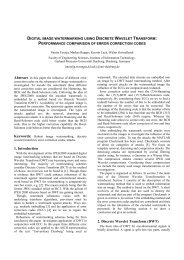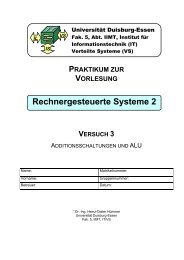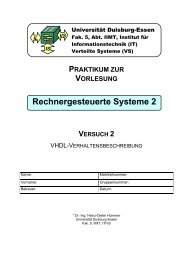(4 slides per page) - Updated
(4 slides per page) - Updated
(4 slides per page) - Updated
Create successful ePaper yourself
Turn your PDF publications into a flip-book with our unique Google optimized e-Paper software.
Overview<br />
Phase 10<br />
Introduction<br />
Notations<br />
Java<br />
Implementation<br />
of modules<br />
Module Tests<br />
Procedure<br />
Example - TLC<br />
Example - SBC<br />
Phase 11<br />
Phase 12<br />
Summary<br />
Overview<br />
Phase 10<br />
Introduction<br />
Notations<br />
Java<br />
Implementation<br />
of modules<br />
Module Tests<br />
Procedure<br />
Example - TLC<br />
Example - SBC<br />
Phase 11<br />
Phase 12<br />
Summary<br />
Phase 10: Implement software components and<br />
test environment<br />
input:<br />
specification<br />
Phase 9<br />
of merged components of<br />
different notations<br />
software component behavior from Phase 8 sequence diagrams<br />
output: implemented software components programming language<br />
test software for software components<br />
programming language<br />
or test language<br />
validation: run tests test results<br />
Constants<br />
in C++:<br />
#define X 2<br />
or const int X = 2;<br />
in Java: final static int X = 2;<br />
5/89<br />
7/89<br />
Overview<br />
Phase 10<br />
Introduction<br />
Notations<br />
Java<br />
Implementation<br />
of modules<br />
Module Tests<br />
Procedure<br />
Example - TLC<br />
Example - SBC<br />
Phase 11<br />
Phase 12<br />
Summary<br />
Overview<br />
Phase 10<br />
Introduction<br />
Notations<br />
Java<br />
Implementation<br />
of modules<br />
Module Tests<br />
Procedure<br />
Example - TLC<br />
Example - SBC<br />
Phase 11<br />
Phase 12<br />
Summary<br />
Notations and concepts<br />
Java<br />
Implementation of modules<br />
Module tests<br />
ClassesinJava<br />
always one file for one class, no header files<br />
name of constructor = name of class = name of file<br />
There is no destructor, the garbage collection frees<br />
memory of unused objects (e.g. for objects set to null).<br />
The entry point of an application is<br />
public static void main (String[] args)<br />
in one class (file).<br />
6/89<br />
8/89



